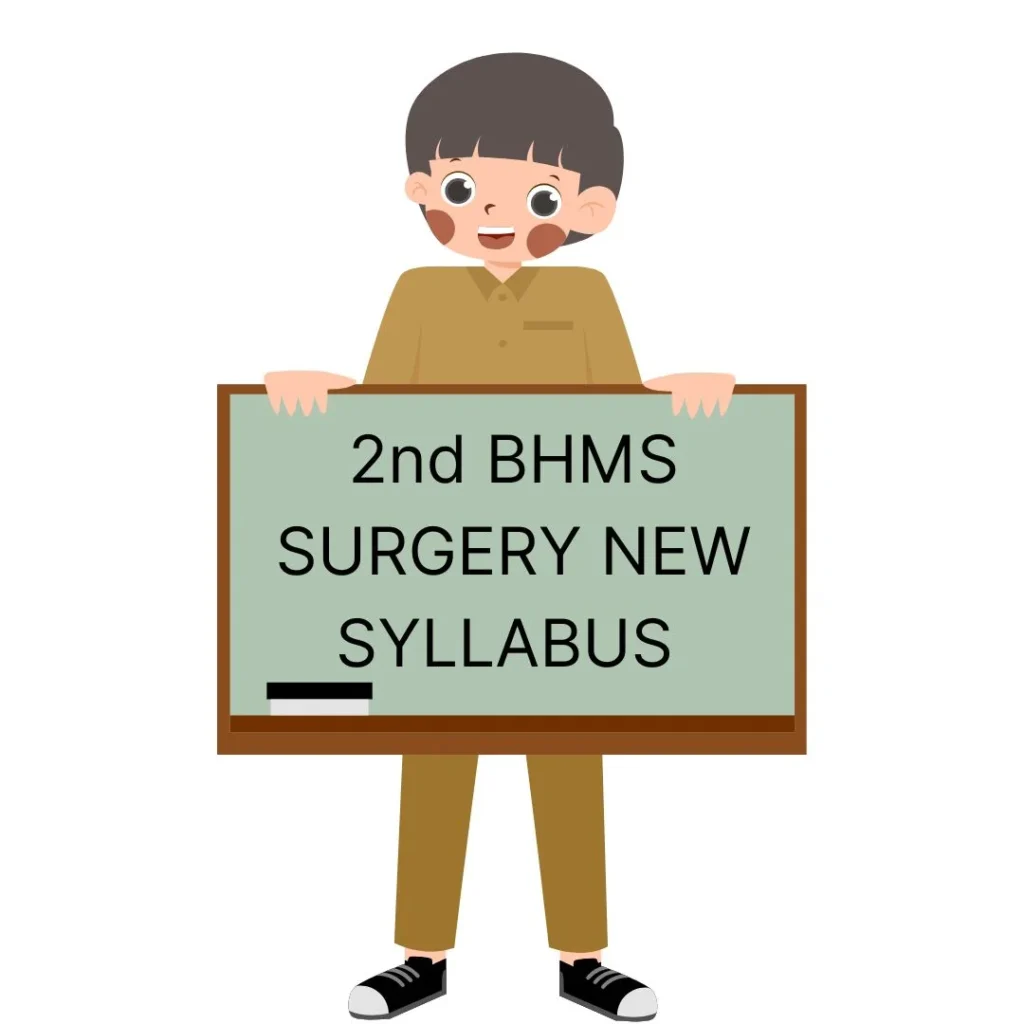Hey future homeopaths! 🎓 If you’re in your 2nd BHMS, you’re probably curious about the Surgery syllabus.
Don’t worry—I’ve got you covered! This post provides a detailed breakdown of the entire syllabus, so you know exactly what to expect.
From understanding surgical conditions to mastering practical skills, we’ll cover it all. Let’s dive in!
2ND BHMS NEW SYLLABUS 2022-2023: SUBJECTS, EXAM PATTERN, AND STUDY TIPS FOR BHMS STUDENTS
2ND YEAR BHMS EXAM PATTERN (2022-2023) – COMPLETE GUIDE WITH SUBJECT-WISE MARKS & STUDY TIPS

Why Study Surgery in Homoeopathy?
Surgery is a critical part of medical science, involving the physical intervention to treat injuries, deformities, or diseases.
While homoeopathy often helps prevent surgical interventions through early diagnosis and treatment, a solid understanding of surgery is essential for homoeopathic physicians.
By studying surgery, you’ll:
- Diagnose common surgical conditions effectively.
- Understand the scope and limitations of homoeopathy in surgical cases.
- Learn to integrate homoeopathic principles with surgical management.
- Provide comprehensive care to patients transitioning between surgical and homoeopathic treatments.
- Make informed decisions about when to refer patients for surgical intervention.
Course Outcomes
By the end of the 2nd BHMS Surgery course, you’ll be able to:
- Diagnose common surgical conditions.
- Understand the role of homoeopathic treatment in pseudo-surgical and true surgical diseases.
- Record a complete surgical case history to identify the correct homoeopathic medicine.
- Perform basic surgical procedures like wound dressing, suturing, and fluid therapy.
- Understand the miasmatic background of surgical disorders.
- Apply materia medica and posology in common surgical conditions.
- Use repertory for homoeopathic prescriptions in surgical cases.
Learning Objectives
At the end of the 2nd BHMS course, you’ll:
- Understand surgical case-taking and symptomatology.
- Demonstrate basic surgical procedures like wound dressing and ABC management.
- Diagnose common surgical conditions taught in the syllabus.
- Understand the role of examination and investigation in surgical disorders.
- Identify referral criteria for medical emergencies and surgical conditions.
- Apply materia medica and posology in surgical cases.
Theory Syllabus
- Introduction to Surgery: Scope and limitations of homoeopathy in surgical conditions.
- Injury: Types, head injury, road traffic accidents, chest and abdominal injuries.
- Wound and Wound Healing: Scar, keloid.
- Haemorrhage: Blood transfusion.
- Shock: Types and management.
- Fluid, Electrolytes, and Acid-Base Balance.
- Burns: Skin grafting.
- Nutrition: Malnutrition in surgical patients, nutritional support.
- Common Surgical Infections: Boil, carbuncle, abscess, cellulitis, erysipelas, hidradenitis suppurativa, septicaemia, pyaemia.
- Special Infections: Tuberculosis, syphilis, AIDS, actinomycosis, leprosy, tetanus, infective gangrene.
- Concept of Swellings: Tumours (benign and malignant), cysts, naevus, melanoma.
- Hernia: Aetiology, classification, clinical features, management.
- Ulcers: Types and management.
- Sinus and Fistula: Clinical features and management.
Practical Syllabus
- Case-taking of surgical cases.
- Examination of trauma cases and transport of the injured.
- Examination of head injury cases.
- Examination of wounds and suture techniques.
- Examination of haemorrhagic cases.
- Examination of shock.
- Clinical evaluation of fluid, electrolytes, and acid-base balance.
- Clinical examination of burns.
- Examination of common surgical infections.
- Examination of special infections.
- Examination of swellings, cysts, and tumours.
- Examination of hernia.
- Examination of ulcers.
- Examination of sinus and fistula.
- ABC management, wound dressing, and fluid therapy.
Assessment
- There will be no final university examination for Surgery in the 2nd BHMS.
- Assessment will be based on Internal Assessment (IA), including Periodical Assessments (PA) and Term Tests (TT).
- Marks obtained in IA will be carried forward to the 3rd BHMS University Examination.
How to Excel in Surgery
- Focus on Case-Taking: Develop strong skills in recording surgical case histories.
- Master Practical Skills: Practice wound dressing, suturing, and ABC management.
- Understand Homoeopathic Integration: Learn how to apply homoeopathic principles in surgical cases.
- Refer to Standard Texts: Use recommended books and resources for deeper understanding.
- Stay Updated: Keep up with the latest advancements in surgery and homoeopathy.
Final Thoughts
The 2nd BHMS Surgery syllabus is designed to equip you with the knowledge and skills to manage surgical conditions effectively while integrating homoeopathic principles.
By mastering this syllabus, you’ll be well-prepared to provide holistic care to your patients.
Good luck, and keep striving for excellence! 🌟
Got questions? Drop them in the comments below!
Let’s help each other succeed. 💪
- 2ND BHMS PATHOLOGY, MICROBIOLOGY, AND PARASITOLOGY SYLLABUS: A DETAILED GUIDE FOR STUDENTS (2022-2023 ONWARDS)
- 2ND BHMS PATHOLOGY, MICROBIOLOGY, AND PARASITOLOGY QUESTION BANK (NEW SYLLABUS 2022-2023 ONWARDS)
- PATHOLOGY PRACTICAL SPOTTING EXAM: A COMPLETE GUIDE FOR STUDENTS
- 2ND BHMS FORENSIC MEDICINE AND TOXICOLOGY SYLLABUS: A DETAILED GUIDE FOR STUDENTS (2022-2023 ONWARDS)
- 2ND BHMS FORENSIC MEDICINE AND TOXICOLOGY QUESTION BANK (2022-2023 ONWARDS)
- 2ND BHMS HOMOEOPATHIC MATERIA MEDICA SYLLABUS: A DETAILED GUIDE FOR STUDENTS (2022-2023 ONWARDS)
- 2nd BHMS MATERIA MEDICA QUESTION BANK: KEY QUESTIONS, REMEDIES, AND STUDY TIPS (2022-2023 SYLLABUS)
- 2ND BHMS ORGANON OF MEDICINE AND HOMOEOPATHIC PHILOSOPHY SYLLABUS: A DETAILED GUIDE FOR STUDENTS (2022-2023 ONWARDS)
- 2ND BHMS ORGANON OF MEDICINE QUESTION BANK: KEY QUESTIONS, STUDY TIPS, AND APHORISM BREAKDOWN (2022-2023 SYLLABUS)
- 2nd BHMS PRACTICE OF MEDICINE SYLLABUS: A COMPREHENSIVE GUIDE FRO STUDENTS (2022-2023 ONWARDS)
- 2ND BHMS GYNAECOLOGY AND OBSTETRICS SYLLABUS: A COMPLETE GUIDE FOR STUDENTS (2022-2023 ONWARDS)
- 2ND BHMS HOMOEOPATHIC REPERTORY AND CASE TAKING SYLLABUS: A COMPLETE GUIDE FOR STUDENTS (2022-2023 ONWARDS)
